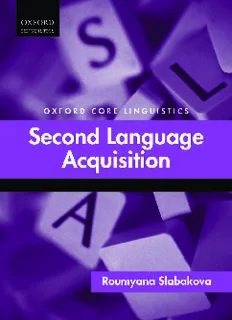
Second language acquisition PDF
Preview Second language acquisition
“Thefirsttextbookinmorethantenyearstoofferasolidlylinguisticaccount ofsecondlanguageacquisition,thisbookclearlyassertsthatthe‘L’of‘SLA’ is for ‘Language’ and it is an excellent alternative to textbooks that increas- ingly focus less on language and more on nonlinguistic variables. Every chapter ends with a series of exercises that use authentic language and data from published articles. This book is a must-read for linguists interested in SLAandsecondlanguageacquisitionresearchersinterestedinlanguage.” KathleenBardovi-Harlig,IndianaUniversity “Awelcomeadditiontothefieldofsecondlanguageacquisition.Itisamust readforstudentsandscholarswhowanttounderstandgenerativeapproaches toSLA.” SusanGass,MichiganStateUniversity “Slabakovaguidesthereadersystematicallythrougharicharrayofobserva- tions and hypotheses, leading up to her ‘bottleneck hypothesis’: a proposal about where learning difficulty lies for second language learners. This thought-provoking overview will be required reading for anyone seriously interestedinunderstandingthecomplexbusinessofhowpeoplelearnsecond languages.” RogerHawkins,UniversityofEssex “An up-to-date, lively and accessible account of the generative approach to second language acquisition research. Readers across the field will find it an extremelyusefulintroduction to key theoreticalideas and currentdebates in generativistSLA,illustratedwithdiscussionofanimpressiverangeofempir- icalstudies.Studentswillenjoytheregularthought-provokingquestionsand activities,aswellasthelinkstoclassroominstruction.” RosamondMitchell,UniversityofSouthampton “A thought-provoking perspective on generative linguistic approaches to second language acquisition, as well as an up-to-date overview of current issuesandresearch.Themainfocusisonadultsecondlanguageacquisition, placed in the broader context of linguistic theory, first language acquisition, andbilingualism.Thebookwillbeofconsiderableinteresttoresearchersand studentsinfieldssuchassecondlanguageacquisition,linguistics,andapplied linguistics.” LydiaWhite,McGillUniversity “Thetimeisrightforanupdateofgenerativeperspectivesonsecondlanguage acquisition and Slabakova’s Second Language Acquisition does the trick. In thisbook,theauthorbringstogetherlinguisticandpsycholinguistic(process- ing) aspects of language acquisition in a variety of contexts, with eventual implicationsforandtieswithinstructionalmatters.Theresultisanup-to-date andreadabletextsuitableforclassroomandnon-classroomusethatwillboth informandprovoke.Highlyrecommended.” BillVanPatten,MichiganStateUniversity OXFORD CORE LINGUISTICS GENERAL EDITOR David Adger PUBLISHED Core Syntax David Adger I-Language:An Introduction to Linguistics as Cognitive Science Second edition Daniela Isac and Charles Reiss Second Language Acquisition Roumyana Slabakova IN PREPARATION Theoretical Morphology Edited by Karlos Arregui-Urbina and Andrew Nevins Introduction to Acoustic Phonetics Charles Reiss Introduction to Linguistic Theory Peter Svenonius Second Language Acquisition Roumyana Slabakova 1 3 GreatClarendonStreet,Oxford,OX26DP, UnitedKingdom OxfordUniversityPressisadepartmentoftheUniversityofOxford. ItfurtherstheUniversity’sobjectiveofexcellenceinresearch,scholarship, andeducationbypublishingworldwide.Oxfordisaregisteredtrademarkof OxfordUniversityPressintheUKandincertainothercountries ©RoumyanaSlabakova2016 Themoralrightsoftheauthorhavebeenasserted FirstEditionpublishedin2016 Impression:1 Allrightsreserved.Nopartofthispublicationmaybereproduced,storedin aretrievalsystem,ortransmitted,inanyformorbyanymeans,withoutthe priorpermissioninwritingofOxfordUniversityPress,orasexpresslypermitted bylaw,bylicenceorundertermsagreedwiththeappropriatereprographics rightsorganization.Enquiriesconcerningreproductionoutsidethescopeofthe aboveshouldbesenttotheRightsDepartment,OxfordUniversityPress,atthe addressabove Youmustnotcirculatethisworkinanyotherform andyoumustimposethissameconditiononanyacquirer PublishedintheUnitedStatesofAmericabyOxfordUniversityPress 198MadisonAvenue,NewYork,NY10016,UnitedStatesofAmerica BritishLibraryCataloguinginPublicationData Dataavailable LibraryofCongressControlNumber:2015948877 ISBN 978–0–19–968726–8(hbk) 978–0–19–968727–5(pbk) PrintedinGreatBritainby ClaysLtd,StIvesplc LinkstothirdpartywebsitesareprovidedbyOxfordingoodfaithand forinformationonly.Oxforddisclaimsanyresponsibilityforthematerials containedinanythirdpartywebsitereferencedinthiswork. ToLydiaWhite Contents Preface xiii Listofabbreviations xvii Listoffigures xix PARTI Language 1 Languagearchitecture 3 1.1 Whatislanguage?Whatisknowledgeoflanguage? 3 1.2 Thelanguagearchitecture 10 1.3 Whatexactlyhastobeacquired? 16 1.4 ThescientificmethodinSLAresearch 18 1.5 Exercises 21 2 Languagevariation 24 2.1 Howdolanguagesdiffer? 24 2.2 PrinciplesandParametersinhistory 29 2.3 TheMinimalistProgram 38 2.4 Whatisthelearningtaskforbilinguals? 44 2.5 Exercises 47 3 Thepsychologicalrealityoflanguageinuse 52 3.1 Whathappenswhenwehearasentence? 53 3.2 Phonologicalperceptionandlexicalrecognition 53 3.3 Morphology 57 3.4 Thesyntacticparser 60 3.5 Modelsofsyntacticprocessing 66 3.6 Workingmemory 72 3.7 Thepsychologicalrealityoflanguageand thegrammar 75 3.8 Exercises 76 viii CONTENTS PARTII Language Acquisition 4 TheCriticalPeriodHypothesis 83 4.1 Theviewfrombiology 83 4.2 Thetwopositionsinsecondlanguageacquisition 85 4.3 Globalnativelikenessversusdifferentsensitiveperiods fortheseparatepartsofthegrammar 86 4.4 Thefirstandthesecondlanguageascommunicating vessels 90 4.5 Effectsofbilingualism:Isthebilingualtwo monolingualsinonemind? 92 4.6 Theimportanceoftheinput 95 4.7 Anindirectwayofappreciatingtheimportance ofinput 99 4.8 Conclusions 102 4.9 Exercises 104 5 Firstlanguageacquisition,twofirstlanguages 110 5.1 Acquisitionofthesoundsofone’snativelanguage 110 5.2 Learningwordmeanings 115 5.3 Acquisitionoffunctionalmorphologyandsyntax 119 5.4 Acquisitionofsemanticsandpragmatics 130 5.5 Bilingual firstlanguageacquisition 132 5.6 Exercises 136 6 Childsecondlanguage,multilingualandheritage languageacquisition,languageattrition 141 6.1 AdultL2acquisition 142 6.2 ChildL2acquisition 142 6.3 L3/Lnacquisition 147 6.4 Heritagelanguagelearners 153 6.5 Languageattrition 158 6.6 Commonalitiesanddifferencesbetweenthefour acquisitioncontexts 161 6.6.1 Isagethecrucialfactorinbilingualacquisition? 161 6.6.2 TheCriticalPeriodHypothesisandthe importanceoftheinput 162 6.6.3 Whatkindofinput? 163 CONTENTS ix 6.6.4 Whichareasofthegrammarsufferwith reducedinput? 163 6.6.5 Arefirstandsecondlanguageacquisition qualitativelydifferent? 164 6.7 Exercises 168 PARTIII Second LanguageAcquisition 7 Acquisitionof(functional)morphology 175 7.1 Morphemestudies 176 7.2 Syntax-before-morphology,White(2003) 182 7.3 RepresentationalDeficitHypotheses 186 7.4 TheMissingSurfaceInflectionHypothesis 189 7.5 TheProsodicTransferHypothesis 194 7.6 TheFeatureReassemblyHypothesis 197 7.7 Exercises 203 8 Acquisitionofsyntax 208 8.1 Ahistoricalexcursionintothenotionofparameter (throughtheages) 208 8.2 RepresentationalDeficitversusFullFunctional Representationaccounts 213 8.3 Wordorder 215 8.4 Verbmovement 221 8.5 Wh-movement 227 8.6 Conclusion 235 8.7 Exercises 236 9 Acquisitionofthementallexicon 245 9.1 Mentalrepresentationandaccessoflexicalitems 246 9.1.1 Bilinguallexiconrepresentationmodels 247 9.1.2 Thebilinguallexiconisintegratedacross languages 248 9.1.3 Thebilinguallexiconisaccessedina language-independentway 249 9.1.4 Languageexposureanduseaffectsthe activationofwordsinthelexicon 250 9.1.5 Languagecontextmaynotaffectbilingual languageactivation 251
Description: